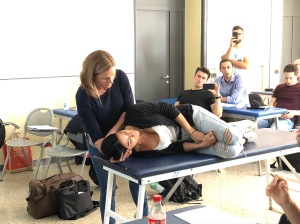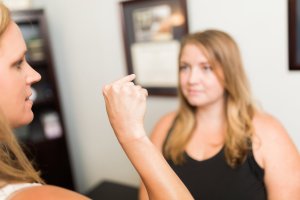Benign paroxysmal positional vertigo (BPPV) can be defined as transient, position-induced torsional, vertical, or horizontal nystagmus with vertigo.
What causes BPPV?
 The pathology is based on displacement of the otoconia in the semicircular canal (canalolithiasis) or attachment of debris/otoliths to the cupula (cupulolithiasis). It can be a primary issue or secondary issue from other conditions.
The pathology is based on displacement of the otoconia in the semicircular canal (canalolithiasis) or attachment of debris/otoliths to the cupula (cupulolithiasis). It can be a primary issue or secondary issue from other conditions.
Unfortunately, the underlying pathology is often obscure and the “main” reason is not always known – hence, what we call idiopathic. In this case, we call it idiopathic BPPV.
What factors lead up to having this diagnosis?
Considering most cases of BPPV are idiopathic, there are other factors associated with BPPV. Everyone wants to know “why” they have this diagnosis and as healthcare professionals, we can’t always pinpoint one specific reason. But, usually there are several reasons that then “overload” your system and cause a “spill-over” effect —- which means your body can’t compensate any further and you get symptoms.
Here is a list of 18, yes 18, factors associated with BPPV!
- Aging
- Migraine
- Meniere’s Disease
- Trauma (such as car accident, concussion, whiplash)
- Infection
- Vestibular Neuronitis
- Idiopathic sudden sensorineural hearing loss
- Sleeping habits
- Osteoporosis and vitamin D insufficiency
- Hyperglycemia and diabetes mellitus
- Chronic head and neck pain
- Vestibule or semicircular canal pathology
- Pigmentation disorders
- Estrogen deficiency
- Neurological disorders
- Auto- immune, inflammatory, or rheumatologic disorders
- Familial or genetic predisposition
- Allergy
Wow, that’s a lot of factors that could lead to you having BPPV!
What does all of this mean for me if I treat BPPV and even other dizzy/vertigo patients?

Basically, this means that the well-rounded treatment is more than just “a manuever”. Yes, we can all knock this out and do a pretty solid job with it! It is the more “complicated” cases that we aim for and can help the most.
Overall, we recommend getting trained in Vestibular Rehabilitation and Upper Quarter Manual Therapy to fully address these patients. Also, take the time and training to examine their symptoms and discuss lifestyle factors and other strategies to not only prevent BPPV from having again but overall, address the entire body and give it all to your patients.
How does BPPV relate to Cervicogenic Dizziness?
For this article and our specialization under the realm of Cervicogenic Dizziness from Cervical Arthrogenic and Myofascial pain, I like to address 2 of the 18 points above — numbers 4 and 11.
#4 Trauma (such as car accident, concussion, whiplash)
We consider someone who has had trauma under the realm of “double entity”. This means that there are at least 2 systems involved (i.e. inner ear and neck pain). This is more common than generally Cervicogenic Dizziness is identified in the literature and quite frankly, we find some type of neck disturbance in pretty much every single one of these patients.
#11 Chronic head and neck pain
This coincides well with Trauma above but may need more explaining to the patient as there is not one single type of injury. This is what you can consider to be more of a single entity instead of just BPPV, but coincides in at least 70% of our BPPV patients. As we discuss in our clinic and courses, we recommend treating BPPV first via canalith repositioning manuevers, but adjunct it with manual therapies and exercises for the neck to fully treat the whole system.
You can learn more about the screening and treatment process of Cervicogenic Dizzinesss through Integrative Clinical Concepts, where the authors (husband–a manual therapist a wife—a vestibular specialist), teach a very unique course combining both the theory and practice of vestibular and manual principles in their 2-day course.
Pertinent to this blog post, the 2nd day includes the “Physio Blend”, a multi-faceted physiotherapist approach to the management of Cervicogenic Dizziness, which includes addressing the articular and non-articular dysfunctions of the neck; as well as graded exercise, vestibular and sensorimotor approaches.
If you would like to host a course for your staff (either a vestibular, neuro, sports or ortho clinic), please do not hesitate to contact me at harrisonvaughanpt@gmail.com for more information.
AUTHORS
Harrison N. Vaughan, PT, DPT, OCS, Dip. Osteopracic, FAAOMPT
Instructor: Cervicogenic Dizziness for Integrative Clinical Concepts
Danielle N. Vaughan, PT, DPT, Vestibular Specialist
Instructor: Cervicogenic Dizziness for Integrative Clinical Concepts
Want to learn in person? Attend a #manualtherapyparty! Check out our course calendar below!
Learn more online - new online discussion group included!
Want an approach that enhances your existing evaluation and treatment? No commercial model gives you THE answer. You need an approach that blends the modern with the old school.
Keeping it Eclectic...- NEW - Online Discussion Group
- Live cases
- webinars
- lecture
- Live Q&A
- over 600 videos - hundreds of techniques and more!
- Check out MMT Insiders




















Post a Comment
Post a Comment